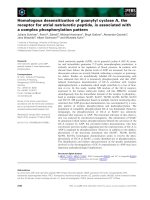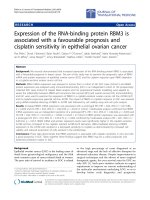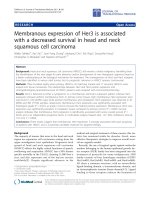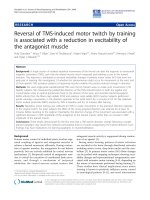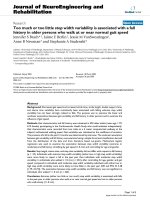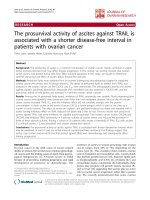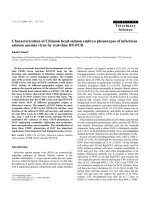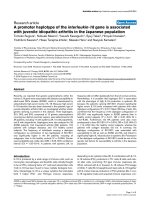Cannabis use is associated with a small increase in the risk of postoperative nausea and vomiting: A retrospective machinelearning causal analysis
Bạn đang xem bản rút gọn của tài liệu. Xem và tải ngay bản đầy đủ của tài liệu tại đây (756.79 KB, 8 trang )
Suhre et al. BMC Anesthesiology
(2020) 20:115
/>
RESEARCH ARTICLE
Open Access
Cannabis use is associated with a small
increase in the risk of postoperative nausea
and vomiting: a retrospective machinelearning causal analysis
Wendy Suhre1* , Vikas O’Reilly-Shah1,2,3 and Wil Van Cleve1,2
Abstract
Background: Cannabis legalization may contribute to an increased frequency of chronic use among patients
presenting for surgery. At present, it is unknown whether chronic cannabis use modifies the risk of postoperative
nausea and vomiting (PONV).
Methods: This study was a retrospective cohort study conducted at 2 academic medical centers. Twenty-seven
thousand three hundred eighty-eight adult ASA 1–3 patients having general anesthesia for non-obstetric, noncardiac procedures and receiving postoperative care in the Post Anesthesia Care Unit (PACU) were analyzed in the
main dataset, and 16,245 patients in the external validation dataset. The main predictor was patient reported use of
cannabis in any form collected during pre-anesthesia evaluation and recorded in the chart. The primary outcome
was documented PONV of any severity prior to PACU discharge, including administration of rescue medications in
PACU. Relevant clinical covariates (risk factors for PONV, surgical characteristics, administered prophylactic
antiemetic drugs) were also recorded.
Results: 10.0% of patients in the analytic dataset endorsed chronic cannabis use. Using Bayesian Additive Regression
Trees (BART), we estimated that the relative risk for PONV associated with daily cannabis use was 1.19 (95 CI% 1.00–
1.45). The absolute marginal increase in risk of PONV associated with daily cannabis use was 3.3% (95% CI 0.4–6.4%).
We observed a lesser association between current, non-daily use of cannabis (RR 1.07, 95% CI 0.94–1.21). An internal
validation analysis conducted using propensity score adjustment and Bayesian logistic modeling indicated a similar size
and magnitude of the association between cannabis use and PONV (OR 1.15, 90% CI 0.98–1.33). As an external
validation, we used data from another hospital in our care system to create an independent model that demonstrated
essentially identical associations between cannabis use and PONV.
Conclusions: Cannabis use is associated with an increased relative risk and a small increase in the marginal probability
of PONV.
Keywords: Cannabis, Postoperative nausea and vomiting, Cross-sectional studies, Machine learning
* Correspondence:
1
Department of Anesthesiology and Pain Medicine, University of
Washington, Box 356540, 1959 NE Pacific St, Seattle, WA 98195, USA
Full list of author information is available at the end of the article
© The Author(s). 2020 Open Access This article is licensed under a Creative Commons Attribution 4.0 International License,
which permits use, sharing, adaptation, distribution and reproduction in any medium or format, as long as you give
appropriate credit to the original author(s) and the source, provide a link to the Creative Commons licence, and indicate if
changes were made. The images or other third party material in this article are included in the article's Creative Commons
licence, unless indicated otherwise in a credit line to the material. If material is not included in the article's Creative Commons
licence and your intended use is not permitted by statutory regulation or exceeds the permitted use, you will need to obtain
permission directly from the copyright holder. To view a copy of this licence, visit />The Creative Commons Public Domain Dedication waiver ( applies to the
data made available in this article, unless otherwise stated in a credit line to the data.
Suhre et al. BMC Anesthesiology
(2020) 20:115
Background
Medicinal use of cannabis was first described in 1840 by
W.B. O’Shaughnessy, a medical doctor and chemist in
Calcutta, who described its use for the treatment of
acute and chronic rheumatism, rabies, tetanus, cholera,
and infantile convulsions [1]. Cannabis is currently classified as a Schedule 1 drug in the United States, a classification for drugs considered by the Drug Enforcement
Agency to have no accepted medical use and an unacceptable risk of abuse [2]. Beginning in 1996, a gradual
process of cannabis legalization has taken place in the
US, with 33 states as well as the District of Columbia
permitting medical use and 14 US states and territories
presently allowing recreational use of cannabis [3]. In
Washington State, where this research was conducted,
recreational use of cannabis by adults 21 years of age
and older was legalized in 2012.
In the nineteenth century, Dr. O’Shaughnessy described the use of hemp seeds to treat many diseases,
and specifically noted that they “allayed vomiting” in
cholera patients. Today, the cannabinoids present in
cannabis are used in a medical context to treat various
medical conditions, among them chemotherapy induced
nausea and vomiting (CINV). Multiple studies using synthetic cannabinoids have shown cannabis to be as effective as other antiemetics for this purpose [4–6].
As cannabinoid compounds have been shown to be effective treatments for CINV, it seems reasonable to conjecture that cannabis use could exert a prophylactic or
therapeutic effect for patients at risk for or suffering
from postoperative nausea and vomiting (PONV). While
several studies have examined the role of therapeutically
administered cannabinoids in the prevention and treatment
of PONV, almost nothing is known about the impact of
chronic use of cannabis on the risk for developing PONV
[7–10]. The present investigation examines whether an association exists between patient-described use and/or frequency of cannabis and the occurrence of PONV following
general anesthesia.
Methods
This study was a retrospective cohort analysis of general
anesthesia cases lasting 30 min or longer conducted at
the University of Washington Medical Center (UWMC)
from July 1, 2016 until September 30, 2018. Data from
Harborview Medical Center (HMC) from the same time
period were used for model validation. Inclusion criteria
were general anesthesia cases for patients aged 18 years
and older with a documented pre-anesthetic evaluation
who also received post-operative care in the Post
Anesthesia Care Unit. Data regarding anesthetic management were obtained from the hospital Anesthesia Information Management System (Merge AIMS, Hartland,
WI). Obstetric and cardiac cases were excluded, as were
Page 2 of 8
cases with an American Society of Anesthesiologists
Physical Classification 4 or greater. Data regarding risk
factors for PONV and pattern of ongoing cannabis use
were gathered from the pre-anesthetic evaluation documented for the case. Data regarding the occurrence of
PONV were abstracted automatically from nursing documentation in the post-anesthesia care unit. Severity of
PONV was not considered in this analysis. The dataset was
obtained from a central repository of perioperative and
anesthetic data maintained by the UW Perioperative and
Pain initiatives in Quality and Safety Outcome Center,
which performed data extraction, validation, and de- identification prior to providing it to our research team. Because
of patient de-identification, this study was exempted from
review by the University of Washington Institutional Review Board as non-human subjects research. This manuscript was prepared in accordance with STROBE guidelines
for improved reporting of observational studies [11].
Primary predictor
Plain text from the preoperative evaluation note regarding
the use of non-prescribed substances/drugs was extracted
and manually reviewed by one of the investigators (WS).
cannabis use as described by the patient was classified by
the investigator as “daily” (used on a daily basis), “current”
(used at present, but less often than daily) or “none” (i.e.
past use was not considered).
Primary outcome
A composite variable constituted by PONV of any severity as recorded by the recovery room nurse, or the
administr����������������������������������������������������������������������������������������������������������������������������������������������������������������������������������������������������������������������������������������������������������������������������������������������������������������������������������������������������������������������������������������������������������������������������������������������������������������������������������������������������������������������������������������������������������������������������������������������������������������������������������������������������������������������������������������������������������������������������������������������������������������������������������������������������������������������������������������������������������������������������������������������������������������������������������������������������������������������������������������������������������������������������������������������������������������������������������������������������������������������������������������������������������������������������������������������������������������������������������������������������������������������������������������������������������������������������������������������������������������������������������������������������������������������������������������������������������������������������������������������������������������������������������������������������������������������������������������������������������������������������������������������������������������������������������������������������������������������������������������������������������������������������������������������������������������������������������������������������������������������������������������������������������������������������������������������������������������������������������������������������������������������������������������������������������������������������������������������������������������������������������������������������������������������������������������������������������������������������������������������������������������������������������������������������������������������������������������������������������������������������������������������������������������������������������������������������������������������������������������������������������������������������������������������������������������������������������������������������������������������������������������������������������������������������������������������������������������������������������������������������������������������������������������������������������������������������������������������������������������������������������������������������������������������������������������������������������������������������������������������������������������������������������������������������������������������������������������������������������������������������������������������������������������������������������������������������������������������������������������������������������������������������������������������������������������������������������������������������������������������������������������������������������������������������������������������������������������������������������������������������������������������������������������������������������������������������������������������������������������������������������������������������������������������������������������������������������������������������������������������������������������������������������������������������������������������������������������������������������������������������������������������������������������������������������������������������������������������������������������������������������������������������������������������������������������������������������������������������������������������������������������������������������������������������������������������������������������������������������������������������������������������������������������������������������������������������������������������������������������������������������������������������������������������������������������������������������������������������������������������������������������������������������������������������������������������������������������������������������������������������������������������������������������������������������������������������������������������������������������������������������������������������������������������������������������������������������������������������������������������������������������������������������������������������������������������������������������������������������������������������������������������������������������������������������������������������������������������������������������������������������������������������������������������������������������������������������������������������������������������������������������������������������������������������������������������������������������������������������������������������������������������������������������������������������������������������������������������������������������������������������������������������������������������������������������������������������������������������������������������������������������������������������������������������������������������������������������������������������������������������������������������������������������������������������������������������������������������������������������������������������������������������������������������������������������������������������������������������������������������������������������������������������������������������������������������������������������������������������������������������������������������������������������������������������������������������������������������������������������������������������������������������������������������������������������������������������������������������������������������������������������������������������������������������������������������������������������������������������������������������������������������������������������������������������������������������������������������������������������������������������������������������������������������������������������������������������������������������������������������������������������������������������������������������������������������������������������������������������������������������������������������������������������������������������������������������������������������������������������������������������������������������������������������������������������������������������������������������������������������������������������������������������������������������������������������������������������������������������������������������������������������������������������������������������������������������������������������������������������������������������������������������������������������������������������������������������������������������������������������������������������������������������������������������������������������������������������������������������������������������������������������������������������������������������������������������������������������������������������������������������������������������������������������������������������������������������������������������������������������������������������������������������������������������������������������������������������������������������������������������������������������������������������������������������������������������������������������������������������������������������������������������������������������������������������������������������������������������������������������������������������������������������������������������������������������������������������������������������������������������������������������������������������������������������������������������������������������������������������������������������������������������������������������������������������������������������������������������������������������������������������������������������������������������������������������������������������������������������������������������������������������������������������������������������������������������������������������������������������������������������������������������������������������������������������������������������������������������������������������������������������������������������������������������������������������������������������������������������������������������������������������������������������������������������������������������������������������������������������������������������������������������������������������������������������������������������������������������������������������������������������������������������������������������������������������������������������������������������������������������������������������������������������������������������������������������������������������������������������������������������������������������������������������������������������������������������������������������������������������������������������������������������������������������������������������������������������������������������������������������������������������������������������������������������������������������������������������������������������������������������������������������������������������������������������������������������������������������������������������������������������������������������������������������������������������������������������������������������������������������������������������������������������������������������������������������������������������������������������������������������������������������������������������������������������������������������������������������������������������������������������������������������������������������������������������������������������������������������������������������������������������������������������������������������������������������������������������������������������������������������������������������������������������������������������������������������������������������������������������������������������������������������������������������������������������������������������������������������������������������������������������������������������������������������������������������������������������������������������������������������������������������������������������������������������������������������������������������������������������������������������������������������������������������������������������������������������������������������������������������������������������������������������������������������������������������������������������������������������������������������������������������������������������������������������������������������������������������������������������������������������������������������������������������������������������������������������������������������������������������������������������������������������������������������������������������������������������������������������������������������������������������������������������������������������������������������������������������������������������������������������������������������������������������������������������������������������������������������������������������������������������������������������������������������������������������������������������������������������������������������������������������������������������������������������������������������������������������������������������������������������������������������������������������������������������������������������������������������������������������������������������������������������������������������������������������������������������������������������������������������������������������������������������������������������������������������������������������������������������������������������������������������������������������������������������������������������������������������������������������������������������������������������������������������������������������������������������������������������������������������������������������������������������������������������������������������������������������������������������������������������������������������������������������������������������������������������������������������������������������������������������������������������������������������������������������������������������������������������������������������������������������������������������������������������������������������������������������������������������������������������������������������������������������������������������������������������������������������������������������������������������������������������������������������������������������������������������������������������������������������������������������������������������������������������������������������������������������������������������������������������������������������������������������������������������������������������������������������������������������������������������������������������������������������������������������������������������������������������������������������������������������������������������������������������������������������������������������������������������������������������������������������������������������������������������������������������������������������������������������������������������������������������������������������������������������������������������������������������������������������������������������������������������������������������������������������������������������������������������������������������������������������������������������������������������������������������������������������������������������������������������������������������������������������������������������������������������������������������������������������������������������������������������������������������������������������������������������������������������������������������������������������������������������������������������������������������������������������������������������������������������������������������������������������������������������������������������������������������������������������������������������������������������������������������������������������������������������������������������������������������������������������������������������������������������������������������������������������������������������������������������������������������������������������������������������������������������������������������������������������������������������������������������������������������������������������������������������������������������������������������������������������������������������������������������������������������������������������������������������������������������������������������������������������������������������������������������������������������������������������������������������������������������������������������������������������������������������������������������������������������������������������������������������������������������������������������������������������������������������������������������������������������������������������������������������������������������������������������������������������������������������������������������������������������������������������������������������������������������������������������������������������������������������������������������������������������������������������������������������������������������������������������������������������������������������������������������������������������������������������������������������������������������������������������������������������������������������������������������������������������������������������������������������������������������������������������������������������������������������������������������������������������������������������������nd vomiting in our study. The simplest hypothesis is
that patients were demonstrating symptoms of cannabis
withdrawal. While cannabis withdrawal symptoms generally take several days to appear, the exposure to emetogenic stimuli (e.g. anesthetic and analgesic drugs,
peritoneal stretch) combined with reduction or abstention from cannabis use in the perioperative period might
unmask withdrawal symptoms earlier than they might
be expected. Another possibility is that patients using
cannabis choose to do so in part because of the drug’s
antinausea properties. In this conception of risk, cannabis itself is not emetogenic, but rather a marker for a patient at elevated risk of PONV who is chronically selfmedicating.
Our study’s observations are strengthened by our use
of a modern statistical technique for obtaining estimates
for causal inference that avoids some of the classical
Page 7 of 8
problems associated with matching and propensity score
estimates. Further, we performed both internal and external
validation analyses, a process which we believe strengthens
our results. As is true of any non-randomized study of an
intervention, we are limited by potential associations between our predictor (cannabis use) and outcome (PONV)
that are not appropriately managed by our statistical
methods. We find it unlikely that a randomized study to
answer this question will ever be conducted, and therefore
hope that other groups with comparable datasets will explore this question and provide additional independent analyses that would provide further confirmation or spur
debate as to the reliability of our findings.
Conclusions
Patients who chronically use cannabis may be at increased risk of postoperative nausea and vomiting following general anesthesia. Further studies seeking to
confirm and extend our findings could examine as to the
symptoms being managed by cannabis use (if patients
are using it medicinally). Furthermore, future studies
would benefit from a finer grained understanding of patient’s frequency, chronicity, route, and quantity of cannabis use, as well as whether the patient has experienced
symptoms during abstention from cannabis use in the
past. Finally, we believe it would be inappropriate on the
basis of our study alone to recommend any modification
in the approach to PONV prophylaxis for the chronic
cannabis user, and encourage providers to wait for
further data to integrate our findings into their clinical
practice.
Supplementary information
Supplementary information accompanies this paper at />1186/s12871-020-01036-4.
Additional file 1: Table S1. Demographic and clinical data for general
anesthetics at HMC. Continuous variables are summarized by mean (sd).
Categorical variables are summarised by n (%). Ordinal variables are
summarized by median and interquartile range
Abbreviations
PONV: Postoperative nausea and vomiting; PACU: Postanesthesia care unit;
BART: Bayesian Additive Regression Trees; CINV: Chemotherapy induced
nausea and vomiting; UWMC: University of Washington Medical Center;
HMC: Harborview Medical Center; sATE: sample average treatment effect;
MCMC: Markov chain Monte Carlo; CHS: Canabinoid hyperemesis syndrome
Acknowledgements
The authors would like to acknowledge the generous support for their
academic time provided by leadership at the University of Washington, the
Department of Anesthesiology and Pain Medicine at the University of
Washington, and Seattle Children’s Hospital.
Authors’ contributions
WS conceived the study, helped draft the analytic plan, contributed to the
statistical analysis of the dataset, and was a major contributor in writing the
manuscript. WVC helped draft the analytic plan, analyzed the dataset,
performed the statistical analysis, and was a major contributor in writing the
Suhre et al. BMC Anesthesiology
(2020) 20:115
manuscript. VORS helped draft the analytic plan, contributed to the statistical
analysis of the dataset, and was a major contributor in writing the
manuscript. All authors have read and approved the manuscript.
Funding
This research did not receive any specific grant from funding agencies in the
public, commercial, or not-for-profit sectors.
Availability of data and materials
The datasets generated and/or analyzed during the current study are
available in the ponvthc repository, hosted at />publication_dataset ( />Ethics approval and consent to participate
This study was exempted from review by the University of Washington
Institutional Review Board.
Consent for publication
Not applicable.
Competing interests
The authors declare that they have no competing interests.
Author details
1
Department of Anesthesiology and Pain Medicine, University of
Washington, Box 356540, 1959 NE Pacific St, Seattle, WA 98195, USA.
2
Perioperative & Pain Initiatives in Quality, Safety, and Outcome, Department
of Anesthesiology and Pain Medicine, University of Washington, Box 356540,
1959 NE Pacific St, Seattle, WA 98195, USA. 3Seattle Children’s Hospital, 4800
Sand Point Way, Seattle, WA 98105, USA.
Received: 19 February 2020 Accepted: 10 May 2020
References
1. O’Shaughnessy WB. On the preparations of the indian hemp, or gunjah
(cannabis indica), their effects on the animal system in health, and their
utility in the treatment of tetanus and other convulsive diseases. Br Foreign
Med Rev. 1840;10:225–8.
2. Drug Scheduling. Accessed 8 Jan 2020.
3. State Medical Marijuana Laws. Accessed 8 Jan 2020.
4. Chang AE, Shiling DJ, Stillman RC, Goldberg NH, Seipp CA, Barofsky I, et al.
Delta-9-tetrahydrocannabinol as an antiemetic in cancer patients receiving
high-dose methotrexate. A prospective, randomized evaluation. Ann Intern
Med. 1979;91:819–24.
5. Duran M, Pérez E, Abanades S, Vidal X, Saura C, Majem M, et al. Preliminary
efficacy and safety of an oromucosal standardized cannabis extract in
chemotherapy-induced nausea and vomiting. Br J Clin Pharmacol. 2010;70:
656–63.
6. Tramèr MR, Carroll D, Campbell FA, Reynolds DJ, Moore RA, McQuay HJ.
Cannabinoids for control of chemotherapy induced nausea and vomiting:
quantitative systematic review. BMJ. 2001;323:16–21.
7. Layeeque R, Siegel E, Kass R, Henry-Tillman RS, Colvert M, Mancino A, et al.
Prevention of nausea and vomiting following breast surgery. Am J Surg.
2006;191:767–72.
8. Levin DN, Dulberg Z, Chan A-W, Hare GMT, Mazer CD, Hong A. A
randomized-controlled trial of nabilone for the prevention of acute
postoperative nausea and vomiting in elective surgery. Can J Anaesth. 2017;
64:385–95.
9. Kleine-Brueggeney M, Greif R, Brenneisen R, Urwyler N, Stueber F, Theiler
LG. Intravenous Delta-9-Tetrahydrocannabinol to prevent postoperative
nausea and vomiting: a randomized Controlled Trial. Anesth Analg. 2015;
121:1157–64.
10. Merriman AR, Oliak DA. Use of medical marijuana for treatment of severe
intractable nausea after laparoscopic Roux-en-Y gastric bypass surgery. Surg
Obes Relat Dis. 2008;4:550–1.
11. von Elm E, Altman DG, Egger M, Pocock SJ, Gøtzsche PC, Vandenbroucke
JP, et al. The strengthening the reporting of observational studies in
epidemiology (STROBE) Statement: guidelines for reporting observational
studies. Int J Surg Lond Engl. 2014;12:1495–9.
Page 8 of 8
12. Jabaley CS, Gray DW, Budhrani GS, Lynde GC, Adamopoulos P, Easton GS,
et al. Chronic atypical antipsychotic use is associated with reduced need for
postoperative nausea and vomiting rescue in the postanesthesia care unit: a
propensity-matched retrospective observational study. Anesth Analg. 2018.
/>13. Apfel CC, Läärä E, Koivuranta M, Greim CA, Roewer N. A simplified risk score
for predicting postoperative nausea and vomiting: conclusions from crossvalidations between two centers. Anesthesiology. 1999;91:693–700.
14. Pierre S, Benais H, Pouymayou J. Apfel’s simplified score may favourably
predict the risk of postoperative nausea and vomiting. Can J Anesth Tor.
2002;49:237–42.
15. Chipman HA, George EI, McCulloch RE. BART: Bayesian additive regression
trees. Ann Appl Stat. 2010;4:266–98.
16. Hill JL. Bayesian Nonparametric Modeling for Causal Inference. J Comput
Graph Stat. 2011;20:217–40.
17. CRAN - Package BART. />Accessed 28 Jan 2020.
18. Elze MC, Gregson J, Baber U, Williamson E, Sartori S, Mehran R, et al.
Comparison of propensity score methods and covariate adjustment:
evaluation in 4 cardiovascular studies. J Am Coll Cardiol. 2017;69:345–57.
19. Fu EL, Groenwold RHH, Zoccali C, Jager KJ, van Diepen M, Dekker FW.
Merits and caveats of propensity scores to adjust for confounding. Nephrol
Dial Transplant. 2019;34:1629–35.
20. Sanger GJ, Andrews PLR. Treatment of nausea and vomiting: gaps in our
knowledge. Auton Neurosci Basic Clin. 2006;129:3–16.
21. Sharkey KA, Darmani NA, Parker LA. Regulation of nausea and vomiting by
cannabinoids and the endocannabinoid system. Eur J Pharmacol. 2014;722:
134–46.
22. Singh P, Yoon SS, Kuo B. Nausea: a review of pathophysiology and
therapeutics. Ther Adv Gastroenterol. 2016;9:98–112.
23. Smith LA, Azariah F, Lavender VTC, Stoner NS, Bettiol S. Cannabinoids for
nausea and vomiting in adults with cancer receiving chemotherapy.
Cochrane Database Syst Rev. 2015;11:CD009464.
24. Whiting PF, Wolff RF, Deshpande S, Di Nisio M, Duffy S, Hernandez AV, et al.
Cannabinoids for medical use: a systematic review and meta-analysis. JAMA.
2015;313:2456.
25. Meiri E, Jhangiani H, Vredenburgh JJ, Barbato LM, Carter FJ, Yang H-M, et al.
Efficacy of dronabinol alone and in combination with ondansetron versus
ondansetron alone for delayed chemotherapy-induced nausea and
vomiting. Curr Med Res Opin. 2007;23:533–43.
26. Richards JR. Cannabinoid hyperemesis syndrome: pathophysiology and
treatment in the emergency department. J Emerg Med. 2018;54:354–63.
27. Kebir O, Lafaye G, Blecha L, Chaumette B, Mouaffak F, Laqueille X, et al.
ABCB1 C3435T polymorphism is associated with tetrahydrocannabinol
blood levels in heavy cannabis users. Psychiatry Res. 2018;262:357–8.
28. Schlienz NJ, Budney AJ, Lee DC, Vandrey R. Cannabis withdrawal: a review
of neurobiological mechanisms and sex differences. Curr Addict Rep. 2017;4:
75–81.
Publisher’s Note
Springer Nature remains neutral with regard to jurisdictional claims in
published maps and institutional affiliations.
